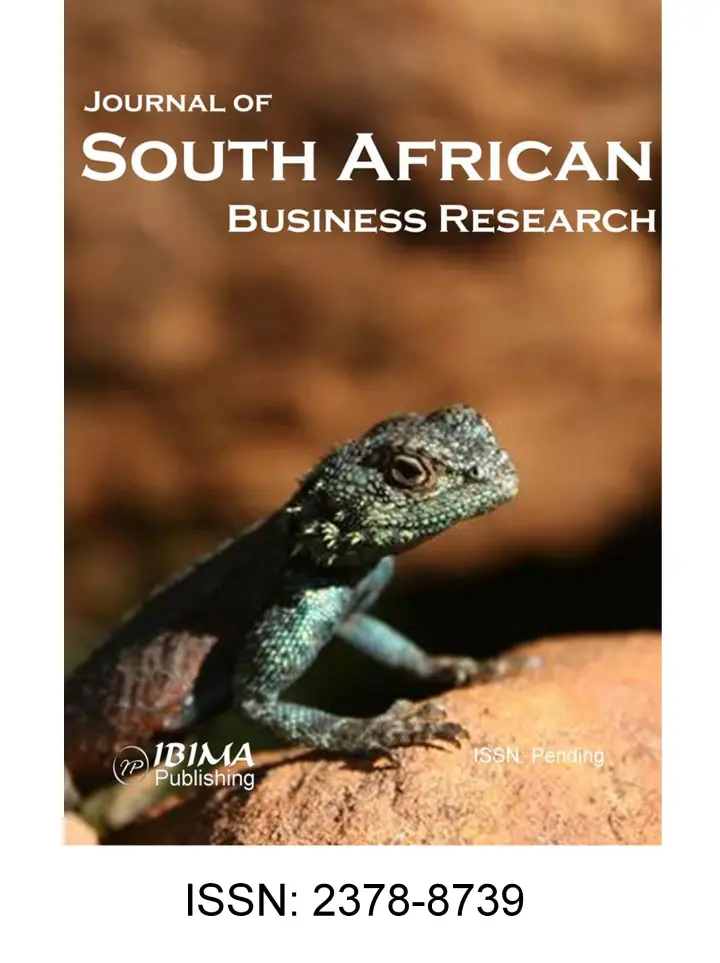Introduction
The two-sector model of Arthur Lewis in the mid-1950s was an attempt to explain the development process in labour-surplus economies of developing nations. The theory, popularly referred to as the two-sector dualistic model posits that the economy is made up of two sectors: the traditional and the modern sectors. This classical model, as opposed to the neoclassical, is of the view that the modern sector is small, uses capital intensive mode of production and pays higher wages than the traditional sector. The traditional sector is, on the contrary, larger, uses little or no capital in the production process and labour is surplus to the extent that its marginal productivity is zero. The labour wage in the traditional sector equals the average total product and, as earlier stated, it is less than the urban wage. Thus, labour transfer from the rural to the urban sector appears rational. This is because of the welfare enhancing attributes it has for rural-urban migrants. Besides, the process of rural-urban labour transfers helps to remove excess labour from the rural traditional sector to the urban industrial sector. At the higher wage paid in the urban sector, the Lewis theory posits a perfectly elastic supply curve of labour to the urban sector from the rural traditional sector until all the surplus labour are removed after which the labour supply becomes positively sloped (Lewis, 1954).
The driver of industrial growth in the modern sector, according to the two-sector model, is the extent of capital accumulation brought about by the reinvestment of profit. The rural-urban labour transfer was expected to continue until all surplus labour is attracted to the urban industrial sector and both the rural and urban wages are equalized. This theory has propelled many LDC’s government into investing heavily in the urban industrial and infrastructural development in order to promote growth and development. The urban industrial growth coupled with urban-bias in development has attracted many residents of rural areas into cities leading to problems like urban congestion and slums, urban open unemployment leading to several social vices. However, the two-sector dualistic model and other conclusions drawn from it have not gone unchallenged as evidenced in Burnside & Dollar, 2000; Easterly 2003; Ranis, 2004; Todaro, 2009, among several others.
Notwithstanding, the model can be credited for explaining the phenomenon of rural-urban labour transfer process where the rural unemployed and the underemployed migrate to the urban centres in search of formal sector employment. However, due to the low labour absorptive capacity of the urban formal sector, migrants who do not obtain the desired wage formal sector jobs do ultimately settle for low-wage urban informal paid employment, or self-employment in the informal economy. Thus, internal movement represents labour redistribution process between areas of perceived low economic opportunities to another area of perceived enhanced economic opportunities. Among the various types of employment opportunities in the informal economy are those requiring little or no restriction of entry and exit, as well as low initial capital. A typical example of such business ventures is street trading in the urban centres of developing economies (Ijaiya, 2000; Lee, 2004; Motala, 2002; Kwankye, Nyarko and Tagoe, 2007; Dudley and Leon, 2010).
Street trading is a sub-sector of the micro and small businesses in the informal economy which has been commonly referred to in the literature as the unregulated and unorganised activities that are prominent in developing nations of the world. Although there are studies directed towards identifying the role of the urban informal in the provision of employment and income (Ogunrinola, 1991; Todaro, 1997; Lund, Nicholson and Skinner, 2000; Cornwell and Inder, 2004; Lall, Selod, & Shalizi, 2006; Debra, 2007; Agbali, 2009; among others) yet, not much is known of the extent of internal migration and the welfare status of migrants compared with that of the non-migrants. Agbali (2009) attempted a study of the street trading sector in Jos, Nigeria, yet his study did not relate to welfare gains of the migrant and non-migrants in the street trading activities. Given the above scenario, several research questions become pertinent. In the first place, how do the recent migrants into the cities survive in the face of open urban unemployment without an unemployment insurance benefit? Second, for those who are constrained to take up informal sector jobs, are such employments taken up as lifetime career or temporary jobs? Third, from what geo-political zones of Nigeria are the migrants largely drawn from? And finally, how do the migrants compare with the non-migrants in terms of welfare in street trading activities?
In order to investigate the issues raised above, this study intends to: (1) identify the proportion and characteristics of migrant street traders in the locations of study; (2) assess the welfare conditions of migrants in street trading in urban cities in Nigeria; and (3) find out whether the street trading jobs are lifetime careers for them or transitory occupations.This paper is in five sections. Following this introductory section is the literature review which is immediately followed by the Methodology of Study. The following section reports the Results and Discussion of the main findings while the last section concludes the paper.
Brief Literature Review
Unemployment as a macro economic problem has become a major characteristic of developing economy and remained an issue in all policies tailored towards development. Unemployment connotes a condition whereby individuals who are willing and able to work could not find suitable paid employment (Briggs, 1973; Gbosi, 1997; World Bank, 1998). It is also described as the difference between the amounts of labour employed at current wage levels and working conditions and the amount of labour not hired at these levels. The rural population that has been consistently estimated to be 70 percent of the total population compared with 30 percent in urban areas.
Some of the reasons for high rural-urban migration include: rural neglect, drudgery of farming occupation, lopsided education curriculum that casts aspersion on manual work but promotes white collar wage employment, concentration of development of social infrastructures in the urban areas, among many other negative factors (Fadayomi, 1979). Thus, internal migration is seen as a strategy to escape poverty and the negative effects of mal-economic development (Zohry, 2009). Specifically, the fundamental pull and push economic factors are common crucial impetuses for the migration and mobility of population across political or geographical boundaries round the globe especially in the developing countries (Morrison et al., 2004; Huang and Zhan, 2005). However, the rate of labour force growth in cities is far greater than the rate of job creation in the urban formal economy. Unfortunately, the surplus labour arising from this imbalance in most cases do not engage in return migration to the rural and other origins, but either join the queue of the unemployed in cities or engage in casual jobs, and/or engage in human capital formation through the apprenticeship system that has wide prevalence in the urban informal sector. The urban sector of most developing economies therefore remains a plethora of both the unemployed and the mass of underemployed labour engaged in various forms of informal endeavours.
Within the informal sector, some of the jobs that can be easily picked up in the informal sector are those that require low initial human and financial capital such as shop-keeping, street vending, shoe shining, car washing, domestic house-help, baby-sitting and so on. Where the migrants have relations that could support them financially either in the city or from their rural origin, they take up apprenticeship training or other form of human capital development in the city with a view to becoming self-employed or gain the desired formal sector employment. In situation where there is no support, they strive to survive through street trading. Studies have confirmed that rural-urban migration has continued to exacerbate urban joblessness considering the fact that the influx surpasses urban job creation and the capacity of both industry and urban social services (Todaro, 1980; Ijaiya, 2000; Lund et al., 2000; Lee, 2004; Kwankye, Nyarko and Tagoe, 2007; Zohry, 2009).
The need to study the pattern of internal migration and its welfare effect among street traders cannot be overemphasized in several respects. First, the high rate of rural neglect in the development process has led to a massive rural-urban migration among the educated youths to escape the drudgery of rural life as pointed out earlier. This increases the supply of labour to the cities in excess of the absorptive capacity of the formal sector enterprises – both private and public. Majority of the excess labour get involved in jobs requiring low entry requirement which explains why the streets are filled with such hawkers and peddlers in city traffic in spite of various forms of harassment received by them from public officials. It is therefore very important to examine the profile of young street traders in order to determine their migration status and hence the welfare implications of their occupation in spite of its many hazards. In addition, there is a dearth of studies of the migrant youth street traders in general and that of the internal migration pattern of street traders in particular in Nigeria. Scanty studies that are available are carried out in South Africa (Mitullah, 2004; Puberdy, 2000; Lund, 1998; Skinner, 1999; Lund and Skinner, 2003), Kenya (Mitullah, 2004), Asian countries (Nirathron, 2006; ILO, 2006; Kusakabe, 2006; Kirk, 2006), and Ghana (Davis, 2008) among others. Some studies carried out in Nigeria include the study of street trading in Jos (Agbali, 2009) and another one on the study of street food vending in the city of Ile-Ife carried out in 1988 (Pearce et al., 1988). Thus, this study of street trading is expected to broaden our understanding in the areas of welfare implications of internal migration among street traders in the informal sector of Nigeria.
Methodology
Research Design, Coverage and Sampling Procedure
This study examined the welfare implications of internal migration on those engaged in street trading activities in Nigeria through a 2011 survey of street traders funded by Covenant University Centre for Research and Development (CUCERD). The study, which is national in scope, interviewed 3,873 street traders in the Northern, Eastern and Western parts of Nigeria. Four major cities representing the regional divisions of Nigeria were purposively selected for the study. The cities are Lagos, representing the West, Aba and Port-Harcourt for the East and Kano representing the North. The direct interview approach was used as the principal method of data collection using two instruments: the questionnaire and the focus group discussions. The questionnaire survey part of the study employed structured face-to-face interviews among the street traders that were selected through a “snowballing on-the-spot method” due to the fact that adequate sampling frame could not be established for the target population. In each city, we identified the areas where there are heavy concentration of street traders during the traffic peak periods, and each area is denoted an enumeration area. From the total number of enumeration areas selected, a minimum of ten percent were randomly selected in each of the cities for the survey. Based on the finance available to the researchers, it was decided that not less than one thousand five hundred street traders, made up of the roving and sedentary types, would be interviewed in each of the regions (North, East and West, Nigeria), thus giving an expected total of 4,500 respondents.
In total, 3,873 street traders were interviewed out of which 61 percent are migrants. The analysis of data was carried out with the Statistical Package for Social Sciences (SPSS) software. Descriptive analyses using frequency distributions, cross-tabulations and other summary statistics are the main method of data reporting. In addition to these, the study specified and estimated a binary logit model as well as an earnings function to examine the welfare implications of street trading among the migrants and non-migrants.
The Models, the Data and Analytical Technique
In this study, two main models were postulated and estimated. The first is a logit model designed to estimate the log of odds of migrants experiencing higher level of welfare in street trading in the urban economy compared to their pre-migration status in the place of origin. The second model is the popular Mincer’s model of income (a proxy for welfare) distribution in an attempt to assess the determinants of welfare among street traders with special reference to migrants in the urban informal economy. Each of these models is described in turn.
Model 1 – The Logistic Model: This is a model that was used to measure the relationship between a categorical dependent variable and one or more independent variables. In general, logistic models are specified as:

Note that, αo represents the intercept and e implies the residual value (or the error term). The X’s are the various explanatory variables conceptualized to be influencing the log of odds of welfare in the informal street trading activity, while the β’s are the coefficient estimates of each of the explanatory variables.
Model 2: The second model postulated in this study relates to the analysis of the factors affecting the income level of the respondents and to find out if the migration variable is statistically significant in its effect on the dependent variable. This is based on the human capital model as specified by Garry Becker (1975) and Jacob Mincer (1974). Using the log of earnings as the dependent variable, equation (3) below is specified to examine the impact of migration status variable in addition to other traditional variables, on the distribution of earnings of respondents. The basic Mincer’s equation is specified as:  ; where Xi are the explanatory variables affecting the level of wages or earnings. More specifically, equation (2) can be stated as:
; where Xi are the explanatory variables affecting the level of wages or earnings. More specifically, equation (2) can be stated as:

Where = Daily profit realized from urban street trading
EDUC: Represents the number of years of formal educational attainment of the respondents before engagement in street trading. Education is expected to contribute positively to earnings and as such .
AGE: This is a proxy for labour market experience in the street trading occupation measured in years. The coefficient of this variable is expected to have a positive value.
AGE2: This is the square of age or experience in street trading which is expected to capture the non-linearity assumption in the age-earning profile. The coefficient estimate of this variable is expected to be negative.
MIGSTAT: Migration status of the respondent: 1 if Migrant, and 0, otherwise. It is expected that the migration should contribute more to earning and as such the sign is expected to be positive.
Results and Discussion
Profile of the Respondents
This section examines the profile of migrants and non-migrants in urban informal street trading against the background of some of the existing literature on urban-ward migration in developing countries. As shown in Table 1, one major observation of urban informal sector activities in Nigeria is that the majority of street traders are male individuals (58.5 percent) who migrated to the cities in search of employment opportunities. This figure contrasts with 41.5 percent of the street traders that are female. Even among the migrants, majority are of male gender as compared to the female. Kano has the largest proportion of male street traders (89.5 percent) as compared to Port-Harcourt and Lagos where there is a preponderance of female street traders. The preponderance of male street traders in Kano cannot be unconnected with the fact that most of the women are in-doors (pudah) in conformity with the religious obligation for married women in Islam, which is the dominant religion of that community.
Historically, right from the colonial times, cities and other administrative centers in Nigeria became magnets for more permanent migratory movements. This process of urban concentration of the population has continued to be a feature of most of the post-colonial developing nations. It has been fueled largely by rural-to-urban migration from small communities and towns to the large administrative centers and colonially-induced primate cities. According to Table 1, majority of the street traders in Nigeria’s large urban centers are migrants, i.e. persons born elsewhere.
Table 1: Percentage Distribution of Respondents by Location, Gender and Migration Status
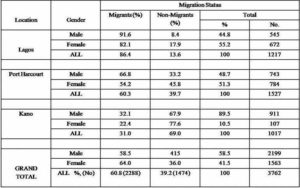
Source: Computed by the authors from the survey data
In Lagos and Port Harcourt, 86 percent and 60 percent respectively of the street traders are migrants, it is only in Kano that the percentage of migrants is low (31 percent) and this might not be unconnected with the fact that in recent times other Nigerians, most especially people from the Southern parts of the country, had to flee as a result of xenophobia and religious conflicts that took place in the Northern part of Nigeria around the time when the survey for this study was carried out. In terms of time of arrival of migrants to their present destination, Table 2 presents some details. According to the figures reported in the table, a high proportion of these migrant street traders are recent residents in the large cities of Lagos, Port-Harcourt and Kano. About 70 percent of them settled in their present locations after between year 2000 and 2011, vis-à-vis 27 percent who arrived between 1980 and 1999. Only 3 percent arrived before 1980.
Table 2: Time of Arrival at Present Destination among Migrants
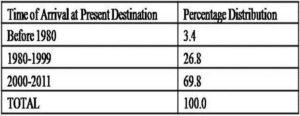
Source: Computed by the authors from the survey data
When the migrant street traders were examined in terms of their region of origin, it was found that most of the cities studied draw their migrant traders from areas of close proximity to justify distance as a veritable factor of internal migration (Table 3). Lagos and its metropolis, for example, draw most of their street traders from the same region or administrative location-the South-West. Fewer migrant traders are drawn from more distant regions.
Table 3: Percentage Distribution of Migrants by Region of Origin
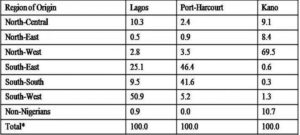
*Approximately Source: Computed by the authors from the survey data
Similarly, Port-Harcourt draws its migrants almost equally from the same region-South-South as well as from an adjacent region-South-East. Kano, which used to be an entrepot, attracting traders and merchants from all regions of the country, draws 70 percent of its migrant street traders from the North-West followed in the order of magnitude by Non-Nigerians (10 percent.), who are likely to be from those Sahelian countries bordering Kano to the North.
Table 4: Percent Distribution of Respondents by Migration Status and Some Selected Personal Attributes 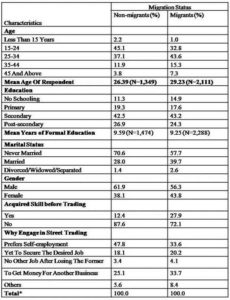 *Approximately Source: Computed by the authors from the survey data
*Approximately Source: Computed by the authors from the survey data
In order to test the selectivity theory of migration, i.e. whether migrant street traders in this study are a selective group with specific attributes already identified in the literature, migrants are compared with non-migrant street traders in the Nigerian large cities of Lagos, Port-Harcourt and Kano. According to Table 4, migrant and non-migrant street traders are concentrated between 15 and 34 years of age, where most rural-urban migrants are found. Migrant street traders are slightly older (with a mean age of 29 years) than non-migrants with a mean age of 26 years. In terms of educational attainment, there is not much difference. Both migrants and non-migrant street traders register a higher proportion of persons with secondary and post-secondary education. This pattern of educational attainment among street traders is in direct correlation with the high rate of unemployment among the educated youths, especially the secondary and post-secondary school leavers in the Nigerian labor market. Both migrant and non-migrant street traders are more males than females. Besides, the majority are single rather than married.
Generally, street trading is not considered to be one of the “high-brow” occupations in the developing world by school leavers; in most cases, it is regarded as the last option for job seekers It is an informal occupation which is non-restrictive in terms of education and skills requirements, space, and low capital demanding. According to Table 4, a smaller proportion of migrant street traders vis-à-vis their non-migrant counterparts are in the trade because it is preferred as a source of self-employment. Rather, a relatively higher proportion of them, i.e. the migrant street traders, are in this trade either to acquire enough capital for other businesses or as a stop-gap before getting the desired job, which is usually either a white-collar or a blue-collar job in the formal urban employment sector. Besides, the lack of skills is a major reason why street trading is usually an attraction to the migrants as well non-migrants.
Migrants and their Trading Enterprises
Most migrants and non-migrants are alike in terms of employment status. They are basically “own” account workers or self-employed given the fact that street trading is largely a non-restrictive “unorganized” informal sector activity that can accommodate all kinds of people working for survival in an economy suffering from a high rate of unemployment and under-employment in the formal enterprises (Table 5). The distribution of establishments and some selected business characteristics by migration status in Table 5 shows that street trading has recruited a high proportion of migrants and non-migrants within the last decade (2000-2011), which has witnessed the bourgeoning of high school leavers, and university graduates that could not find employment in the formal public and private establishments due to public policies and programs that are not employment-generating.
Table 5: Distribution of Respondents by Migration Status and Some Selected Business Characteristics
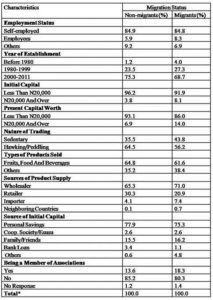
*Approximately Source: Computed by the authors from the survey data
Most street trading activities are carried out by peddling the wares for sale. However, slightly more migrants than non-migrants carry out their street trading by operating from road-side stalls rather than hawking goods, which are in most cases perishable such as, fruits, processed food items and bottled drinks. Their sources of goods supply point to the strong linkages between the informal and formal sector activities as migrants and non-migrants alike depend largely on whole sale distributors in the organized private sector for the goods being retailed on the streets. Only a few of them with much lower funds to invest depend on retailers.
Given the usually low capital inputs required in informal activities such as street trading, most migrants and non-migrants operate their activities with less than 20,000 Naira. The major source of funding deployed to their trading activities is from personal savings. About 75 percent of the migrants depend on this source of capital vis-à-vis 68 percent of non-migrants while a fairly significant number, about 15-16 percent of them, depend on family and friends for funding. The presence of networks and organizations that bind individuals with common interests together is often referred to as “social capital”. Social capital encourages the smooth running of the economy by preserving both individual and group interests in economic and social interactions on the basis of mutual trust as opposed to legality. Both the migrant and non-migrant street traders lack this form of social protection as less than 20 percent of migrants and less than 15 percent of non-migrants belong to any association that could protect their interests.
Table 6: Changes in Returns (in %) to Street Trading by Migration Status

Source: Computed by the authors from the survey data
Even though street trading, according to earlier comments, is not a preferred occupation for school leavers and youths who constitute the bulk of the operators, this study shows that it is asset-building and also yields much beyond a “subsistence” wage.
According to Table 6, operators, (i.e. both the migrants and non-migrants) have experienced substantial growth in their capital investments and a much more substantial increase in their daily profit from the business. Present capital worth vis-à-vis initial capital outlay is relatively more for the migrants than non-migrants. Similarly, the current daily profit has outstripped the daily profit when the business started.
Perception of Well-Being and Determinants of Welfare (Earnings) among Street Traders in Nigeria.
Perception of Well-Being by Respondents
In spite of the fact that street trading is not a job of first priority for the respondents in this study, yet, many of them reported welfare enhancement in street trading compared to their previous engagements. Table 7 describes the perception of street traders of their well-being (as street traders) and future job aspirations. A higher proportion of migrants vis-à-vis their non-migrant counterparts have a much more positive feeling of well-being as street traders in spite of the fact that both groups have benefited from street trading.
Table 7: Perception of Well-Being and Future Job Aspirations by Migration Status

*Approximately Source: Computed from the survey data by the authors.
However, when we examine the future job aspirations of street traders vis-à-vis why they were into street trading, it can be inferred that the preference for street trading on the account of self-employment is as strong a reason as a source of raising funds for another endeavor.
Has there been improvement in Welfare since Engaged in Street Trading? The Binary Logistic Regression Approach
Given the high level of unemployment in the national economy, many of the unemployed had to take up street trading as a coping strategy since there is no system of unemployment insurance that can provide funds for basic necessities of life. This study found out if there had been a welfare change to respondents since they engaged in the informal street trade in the urban economy in addition to finding out the future career expectation of the operators. The responses from the sampled street trading operators revealed that over three-fifths (representing 2,304 street traders) of the respondents reported improved welfare since they engaged in street trading. Disaggregated by migration status, over 71.2 percent of those reporting improved welfare are migrants while the remaining 28.8 percent are non-migrants. In terms of future career prospect, many of the respondents reveal strong preference for changing job and/or go father for higher formal education, travel abroad for better job/higher studies, settle down in self-employment in the informal sector; while many of the migrants intend to return to their home town, perhaps to start off a personal business. The following section discusses the logit model estimated to determine the log of odds of improvement in welfare in street trading.
The binary logistic regression made use of equation (1) to assess the impact of a number of factors on the likelihood that respondents experience an improvement in welfare since engaging in the informal self-employment as street traders rather than remaining in the previous engagement. Table 8 shows the result of the logistic regression results. In all, eleven basic variables were identified as the main explanatory variable to the independent categorical variable (Better off =1, zero otherwise); and these explanatory variables were expanded to twenty-six; made up 16 whose parameters were estimated while the remaining 10 were excluded to avoid dummy variable trap (Gujarati, 2009). Nine of these variables are statistically significant at the specified level of confidence. Age (up to 25 years), Educ2 and Educ3, Marstat1 and Marstat2, Region of origin, Years of experience in street trading, Gender and Migration status exert statistically significant influence on the log of odds of experiencing improved welfare which is the independent variable. Two of these variables appear very strong on their influence on welfare and these are: secondary education with an odd ratio of 2.886 and a Wald statistic of 76.471; as well as Migration Status (Migrant=1) with an odd ratio of 2.456 and Wald statistic of 89.377.
Table 8: Logistic Regression on the Probability of Well-Being un Informal Street Trading. (Dependent Variable: Better-Off un Street Trading=1; Zero Otherwise)

Source: Computed from the survey data by the authors.
Statistically significant at: *, 1% level; **, 5% level and ***; 10% level.
Determinants of Earnings in Urban Informal Street Trading
An important variable used as a measure of welfare in this study is the level of earnings which was captured by current daily profit from street trading activities. By the use of multiple regression analysis, daily earnings were examined in line with the factors affecting its distribution among respondents, noting especially both the magnitude and direction of the migration status variable. Given the result of the logistic regression analysed and reported in Table 8, a multiple linear regression analysis, shown in Table 9 was generated from the Mincer equation stated as equation 3 above. In general, a linear regression gives the coefficient estimates of specified explanatory variables that best predict the value of the dependent variable. In this case, the dependent variable is the Log of earnings while the explanatory variables are as stated in the equation.
Table 9 shows the regression result of the earnings function using twelve main variables. From these main variables, twenty-six other variables were derived out of which ten were deliberately excluded to avoid the usual dummy variable trap. The coefficient estimates of the remaining sixteen variables are shown in the table with the level of statistical significance of each clearly stated. Worthy of note is the fact that migration variable is statistically significant; meaning that being a migrant enhances earnings in street traders. This is in consonance with the postulation of human capital theory (Becker, 1975).
Trading location also proved to be a strong determinant of earnings, as those in Port-Harcourt earn more than those in Kano (the reference category) while those in Lagos are found to earn less than those in Kano. The coefficient estimate of the Port-Harcourt dummy has the highest coefficient estimate (0.880 and 0.838) and has the highest t-statistic (22.865 and 16.838 in regressions 1 and 2 respectively). The importance of Port-Harcourt to street trading might not be unconnected with the fact that it is a city with higher level of economic activities due to oil businesses in and around the city in addition to being a State Capital. However, one is surprised to find out that the Kano enhances earnings in street trading better than Lagos in a statistically significant sense. The reason for this might not be unconnected with the Boko Haram insurgency that has been ravaging the city since around 2009, among other Northern cities, and this has led many non-natives to flee the city for safety. The fewer traders left behind might have been experiencing higher earnings due to higher risk being taken to continue to sell on the street.
Table 9: Determinants of Earnings among Street Traders in Nigeria
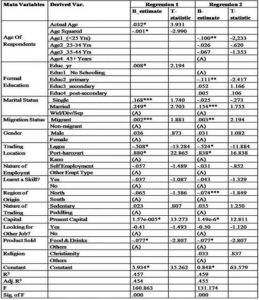
Dependent Variable: Log of daily profit in street trading
Source: Computed by the authors from the survey data. Statistically significant at: *, 1% level; **, 5% level and ***; 10% level.
Two other human capital variables included in the model are worthy of attention and discussion. These are the age (Actual Age) and education (Educ_Yr) variables in Regression 1. Measured in number of years, age and its square are statistically significant in explaining the level of earnings as predicted by human capital theory. From regression 1, it is evident that age contributes to earnings and the inverted-U-shaped wage paths that peaks in middle age and declines smoothly thereafter is confirmed for street traders. It should be noted however, that this concept has not escaped criticisms by scholars (See for example, Casanova, 2013). However, when the same age variable was entered into the regression analysis in categorical forms as Age1 through Age4 (Regression 2), only the first category (Age1) was statistically significant while the others are not. For the education variable in Regression 1, Educ_Yr is statistically significant while in categorical form, only Educ2 (in Regression 2) is found to be statistically significant. From these, it can be inferred that both education and age contributes to earning, however, the differential impact of each differs. Finally, it is noticed that present capital of the respondents contributes significantly to earnings in the informal street trading.
Summary of Findings, Implications of the Study and Conclusion
This study examines the welfare of migrant and non-migrant street traders in urban cities in Nigeria. Given the high rate of urban open unemployment among the youths especially, this study has shown that the urban informal economy has provided, to a large extent, an opportunity for the economically active and educated youths in Nigeria who would have remained marginalized in the formal economy. In general, street trading is an activity which is physically exhausting, risky, and which municipal authorities in many developing nations are illegalizing. In spite of all of these, street trading has been providing employment and income for migrants to cities from the surrounding areas due to the fact that the capital required for starting is minimal while there is no formal requirement to satisfy apart from being careful not to be arrested by the public authority officials.
This study found out that 61 percent of street traders are migrants, 56 percent are male while about 70 percent of them arrived their destination within the last decade (2000-2011) or less. Migrants in each of the cities studied are drawn from the areas of close proximity to that city, thereby justifying an important postulate of the relationship between distance between the origin and destination of migration. In terms of welfare, 71.7 percent of the migrants reported improved welfare vis-a-vis 45 percent among non-migrants. In spite of this, however, 48.6 percent of the migrants are keen on securing other job as compared with about 51 percent among non-migrants. Using current daily profit as a measure of welfare, an earnings function specified and estimated showed that being a migrant enhances welfare rather than otherwise. In addition, other human capital variables like education, and age (a proxy for labour market experience) are statistically significant in their contribution to earnings in the street trading sub-sector of the urban informal economy in Nigeria.
An important implication for policy formulation and further research can be gleaned from this study. The findings of this study suggest that in the current situation of high open unemployment in urban and rural areas of Nigeria, migrating to the cities to take up informal income activity like street trading is an economically rewarding venture among the unemployed and/or the underemployed from areas surrounding the cities. Thus, despite the dearth of formal sector wage employment, migrating to the cities is economically rewarding for the migrant by providing immediate source of sustenance as well as promising a platform for future desired career development.This attraction and the resultant continual rural-urban migration, is expected to compound the social and economic problems in cities. Therefore, policy measures like placing a ban on street trading, constant arrest, confiscation of wares and prosecuting street traders may not be effective since welfare benefits from outweighs the costs. Therefore policy measures that will create income and employment opportunities in the surrounding areas of cities, either in formal or informal sector is expected to stem the pressure of rural-urban migration in Nigeria. More importantly, provision of cheap source of capital for the skilled persons among the street traders would be an encouragement to stop them from the risky activity of street trading and thus provide opportunity of regular employment.
Acknowledgement
The survey research, on which the findings of this paper are based, was supported by a generous grant from the Covenant University Centre for Research and Development (CUCERD), Nigeria.
(adsbygoogle = window.adsbygoogle || []).push({});
References
1.Agbali & Emmanuel E. (2009). ‘Being a BSc Research Project in the Faculty of Environmental Sciences,’ University of Jos, Plateau State, Nigeria, Street Trading in Jos.
2.Briggs, J. E. (1973). ‘Unemployment Statistics and What They Mean,’ Monthly Labour Bulletin, US Department of Labour. Washington DC.
Google Scholar
3.Burnside, C. & David, D. (2000). “Aid, Policies and Growth,” American Economic Review, Vol. 90, No. 4, pp. 847-868
Publisher – Google Scholar
4.Cornwell, K. & Inder, B. (2004). “Migration and Unemployment in South Africa: When Motivation Surpasses the Theory,” Mimeo Monash University January 004 .
Publisher – Google Scholar
5.Davis, J. (2008). “Selling Wares on the Streets of Accra: A Case Study of Street Hawkers in Ghana’s Capital,” FOCUS on Geography, 51(3), 2008.
Publisher – Google Scholar
6.Dudley, L. P. & Leon F. B. (2010). “Population and Society: An Introduction to Demography,” Cambridge University Press. 2010. P301-323. ISBN 978-0-521-87287-4
Publisher – Google Scholar
7.Fadayomi, T.O. (1979). “Rural Migration and Rural Development an Exploratory study of Return migrants in selected Rural Communities of Nigeria,” A Reviewed Version of Paper Presented at 10th Annual Conference of the Canadian Association of African Studies. University of Guelph, Ontario, Canada.
Publisher – Google Scholar
8.Gbosi, A. N. (2006). ‘Modern Labour Economics and Policy Analysis,’ Abakaliki, 2006
Google Scholar
9.Huang, P. & Zhan, S. (2005). ‘Internal Migration in China: Linking it to Development,’ Paper for Regional Conference on Migration and Development in Asia Lanzhou, China. Ministry of Foreign Affairs, People’s Republic of China. 14-16 March, 2005
Google Scholar
10.Ijaiya, G. T. (2000). “Urban Poverty Incidence in Nigeria: A Case Study of Ilorin Metropolis,” The Nigerian Journal of Economic and Social Studies. Vol. 42 No 3. Nigerian Economic Society. ISSN 0029 0092. Pp411-426
Publisher – Google Scholar
11.International Labour Office (1990). ‘Economically Active Population 1950-2025,’ Vol. 6. (Methodological Supplement). International Labour Office, Geneva.
12.International Labour Office (2009). ‘ILO Standards on Occupational Safety and Health. Promoting a Safe and Healthy Working Environment,’ First edition 2009. International Labour Office, Geneva. P1-171. ISBN 978-92-2-120634-7, ISSN 0074-6681
13.International Labour Organization (2002). ‘Women and Men in the Informal Economy: A Statistical Picture,’ Employment Sector, International Labour Office, Geneva
Google Scholar
14.International Labour Organization (ILO) (2006). Southeast Asia Countries. Available from www.ilo.org/public/libdoc/ilo/2006/16B09_343_engl.pdf
15.International Labour Organization (ILO) (2002). ‘Key Indicators of the Labour Market 2001-2002,’ ILO, Geneva, February 2002;
16.Ishola, R. A. (2008). Reducing Unemployment through the Informal Sector: A Case Study of Nigeria, European Journal of Economics, Finance and Administrative Sciences, Issue 11, 2008. EuroJournals, Inc. 2008. ISSN 1450-2275. Pp 97-106
17.Kirk, A. (2006). ‘Just Hardwork: Proletarian Entrepreneurs,’ Retrieved July 18, 2012, from TerraViva Bangkok, Thailand. www.ipsterraviva.net/tv/bangkok/viewstory.asp?idnews=625
Google Scholar
18.Kusakabe K. (2006). ‘Policy Issues on Street Vending: An Overview of Studies in Thailand, Cambodia, and Mongolia. Bangkok,’ International Labour Office, 2006
Google Scholar
19.Kwankye, S. O., Nyarko P. E. & Tagoe C. A. (2007). ‘Reproductive Health: implications of Street Hawking in Accra,’ Paper presented at the Fifth African Population Conference organized by Union for African Population Studies, Arusha, Tanzania, 10-14 December, 2007.
Google Scholar
20.Lall, S. V., Selod, H. & Shalizi, Z. (2006). “Rural-Urban Migration in Developing Countries: A Survey of Theoretical Predictions and Empirical Findings,” World Bank Policy Research Working Paper 3915 .
Publisher – Google Scholar
21.Lee, Sabrina (2004). “Assessing the Vulnerability of Women Street Traders to HIV/AIDS: A Comparative Analysis of Uganda and South Africa.” HEARD, July 2004
Publisher – Google Scholar
22.Lewis, W. A. (1954). “Economic Development with Unlimited Supplies of Labour,” Manchester School, May 22, pp 139-192.
Publisher – Google Scholar
23.Lund, F. (1998). “Women Street Traders in Urban South Africa: A Synthesis of Selected Research Findings,” CSDS Research Report No 15. University of Natal, Durban.
Publisher – Google Scholar
24.Lund, F. & Skinner, C. (2003). ‘The Investment for the Informal Economy: A Case of Durban,’ South Africa. Background Paper for the 2005 World Developmen Report .
25.Lund, F., Nicholson, J. & Skinner, C. (2000). “Street Trading,” Durban: University of Natal, School of Development Studies.
Google Scholar
26.Mitullah, Winnie V. (2004). ‘A Review of Street Trade in Africa: Working Draft,’ Nairobi: University of Nairobi, Institute for Development Studies
Google Scholar
27.Morrison, P. A. Bryan T. M. & Swanson D. A. (2004). ‘Internal Migration and Short-Distance,’ In (eds.) Siegel Jacob S and Swanson David A. The Methods and Materials of Demography, Second Edition. Elsevier Academic Press. Paris. 2004
Google Scholar
28.Motala, S. (2002). “Organizing in the Informal Economy: A Case Study of Street Trading in South Africa,” Series on Representation and Organization Building. SEED Working Paper No. 36. Development Job Creation and Enterprise Department, International Labour Office. Geneva. ISBN 92-2-113573-X
Publisher – Google Scholar
29.Nirathron, Narumol (2006). ‘Fighting Poverty from the Street: A Survey of Street Food Vendors in Bangkok,”BangkokInternational Labour Office, 2006. New York. pp. 87-110
Google Scholar
30.Patterson, Okafor & Williams (2006). ‘Globalization and employment Generation. Evaluating the impact of trade on Aggregate employment in Nigeria’s In Industrial Sector,’ NES Annual Conference, Nigeria. 2006.
Google Scholar
31.Pearce, T. O., Kujore, O. O., & Agboh-Bankole, A. (1988). “Generating an Income in the Urban Environment: The Experience of Street Food Vendors in Ile-Ife, Nigeria. Africa,” Journal of the International African Institute, 58 (4), 385-400.
Publisher – Google Scholar
32.Skinner, C. (2008). “Street Trade in Africa: A Review,” School of Development Studies Working Paper No 51.
Publisher – Google Scholar
33.Todaro, M. P. (1997). “Urbanization, Unemployment and Migration in Africa: Theory and Policy,” Mimeo New York University 1997 No. 104 .
Publisher – Google Scholar
34.Todaro, M. P. (1980). “Internal Migration in Developing Countries: A Survey,” In Easterlin Richard A. (ed.) Population and Economic Change in Developing Countries. National Bureau of Economic Research. University of Chicago Press. 1980. ISBN: 0-226-18027-1. Pp. 361-402.
Publisher – Google Scholar
35.Zohry, A. (2009). “The Development Impact of Internal Migration: Findings from Egypt,” International Union for the Scientific Study of Population, XXVI IUSSP International Population Conference. Marrakesh, Morocco 27 Sep. – 2 Oct. 2009.
Publisher – Google Scholar



